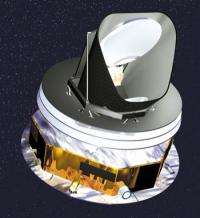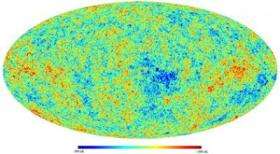Looking Back 13.8 Billion Years: The countdown for Planck satellite has started

The Planck satellite is set to eavesdrop with hitherto unsurpassed precision on the echo of the Big Bang, thereby providing a sharp image of the infancy of the Universe. The satellite is due to be launched on board an Ariane 5 rocket on April 16th. The aim of this international mission, managed by the European Space Agency (ESA), is to map the cosmic microwave background. The Max Planck Institute for Astrophysics in Garching is the German partner in this project. Researchers have spent a decade developing important software components that have now been delivered to the collaboration.
380,000 years after the Big Bang, all the structures we see in the universe today - stars, galaxies and galaxy clusters - were present in embryonic form as minute fluctuations in the density of matter. At that time, the Universe became transparent. The light freed then is still travelling through the cosmos today, and is measurable as the cosmic microwave radiation. This radiation provides an accurate image of the appearance of the Universe 13.8 billion years ago - precisely at the epoch when it became transparent.
The microwave background shows us the embryonic density fluctuations as miniscule variations in temperature, first predicted 40 years ago by Rashid Sunyaev, now Director at the Max Planck Institute for Astrophysics. The first discovery of these temperature fluctuations by the COBE satellite, 25 years later, was awarded the Nobel Prize for Physics in 2006.

The Planck space telescope will measure the microwave background for between 18 and 30 months from a location close to the so-called second Lagrange point of the Sun-Earth system. The satellite has one high-frequency and one low-frequency instrument and a total of nine different frequency bands. Temperature maps will not just provide an image of the early phase of our Universe. They will also allow scientists to answer important cosmological questions: What exactly happened during the Big Bang? What is today's Universe made of? How old is it? How did its structures form?
These measurements could also help verify the theory of inflation. Space is supposed to have undergone a phase of explosive expansion, when the universe was all of 10 to the power of -35 seconds old. Minute quantum fluctuations of the hypothetical energy field which drove this spatial explosion are believed to have produced the density fluctuations visible in the microwave background from which today's galaxies emerged.
"The theory of inflation, with its claim to be able to trace the fundamental characteristics of today's cosmos back to this bizarre expansion epoch, is a seemingly unbelievable idea and it is absolutely essential that it be tested experimentally," says Torsten Enßlin, cosmologist and manager of the German Planck group located at the Max Planck Institute in Garching.
It may never be possible to measure this epoch and so prove the theory of inflation directly. However, the temperature fluctuations in the microwave background conceal messages from this time that can be decoded through statistical analysis of the measurements of Planck. The Planck collaboration hopes to obtain first results by studying the polarization of this radiation. They could thereby open a new window to the very early Universe. "Current ideas about the first split seconds in the life of the Universe could be verified, confirmed or completely revised using such precise polarization measurements", says the Garching-based scientist.
The Max Planck Institute for Astrophysics represents Germany in the Planck Consortium and carried out part of the software development for the project. It has developed a mission simulation software package over the past decade for the data processing centers in Paris and Trieste. Such simulations generate synthetic datastreams that resemble the real one expected from the satellite. However, in the case of the synthetic data streams, the exact properties of the virtual Universe that produced them are known. This enables the testing and optimization of the data processing procedures, critical elements of this complex mission.
"Following the verification and calibration of the data transmitted daily from the satellite to Earth, individual maps are generated for the instruments' nine frequency bands. This happens in the two data processing centers, in Trieste and Paris, depending on the wavelength range," says Wolfgang Hovest, a software developer from the Garching Planck group. These maps are then separated into different components, such as galactic radio emission, dust radiation, microwaves from other galaxies, and the cosmic microwave radiation.
The German Planck team also developed a database-supported graphic workflow engine, the Planck Process Coordinator (known as the ProC). This important component of the project software infrastructure permits the construction, implementation, and monitoring of complex data processing pipelines.
With the simulation package and the Process Coordinator, the Max Planck Institute for Astrophysics has contributed key components to the Planck mission. This project presents enormous challenges both to astrophysicists and to computer scientists. As the leading German partner, the Institute will be intensively involved in the scientific evaluation of the data. In addition to the cosmological questions at the heart of the project, research will also focus on more traditional astrophysical objects, such as galaxy clusters or active galactic nuclei.
Related links:
Planck-group at the Max Planck Institute for Astrophysics
planck.mpa-garching.mpg.de/
Planck Science Team at ESA
www.rssd.esa.int/index.php?project=Planck
Source: Max-Planck-Gesellschaft





















